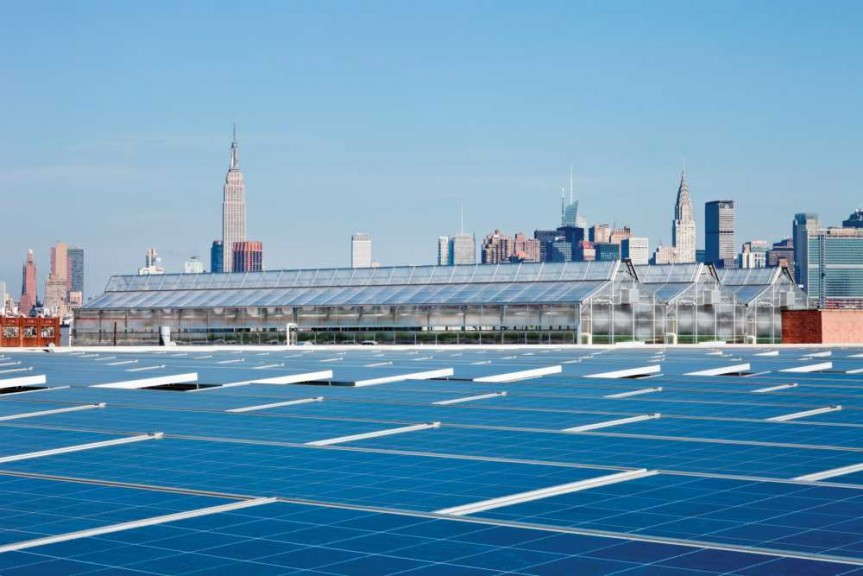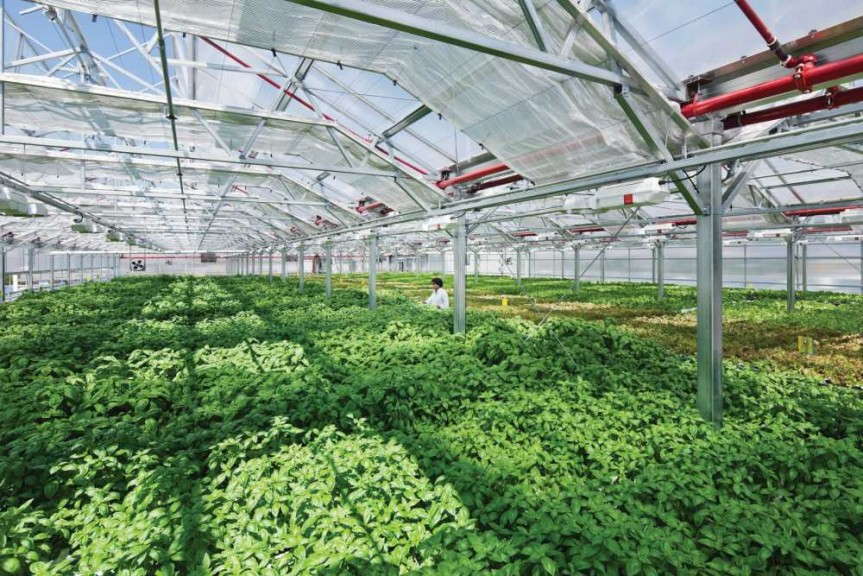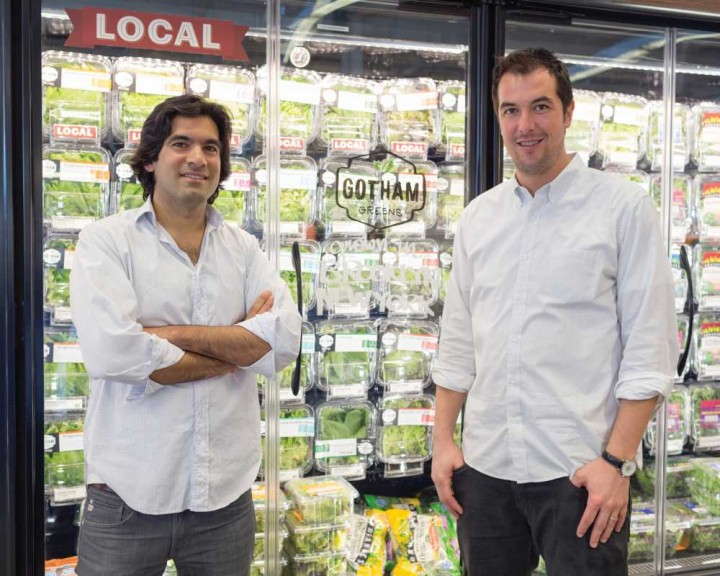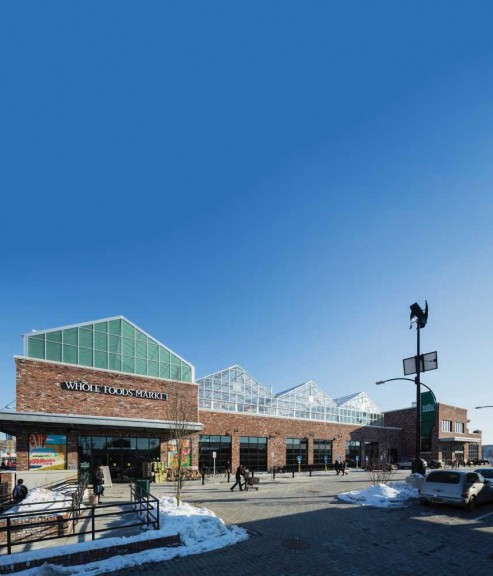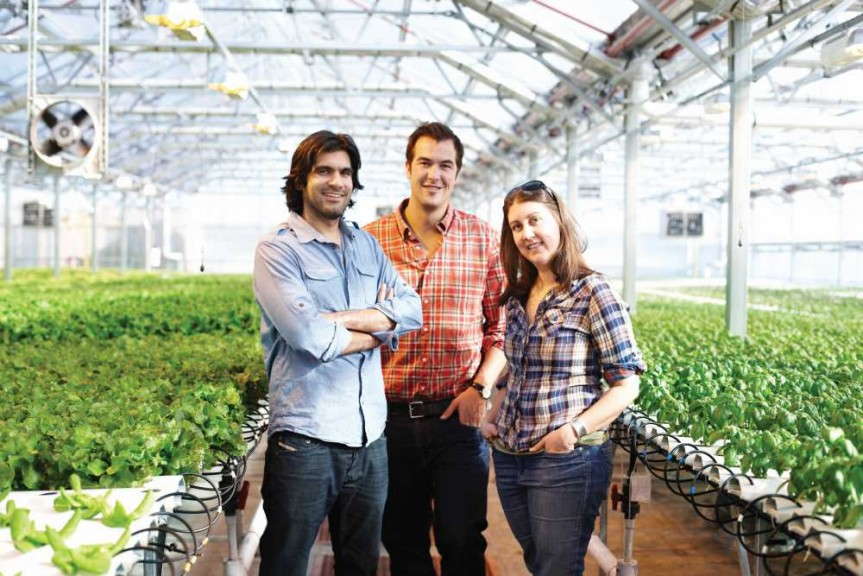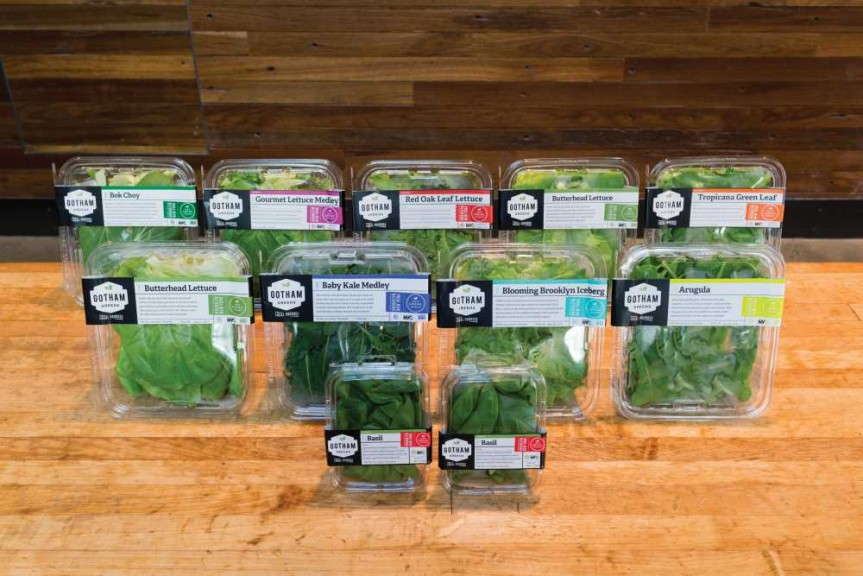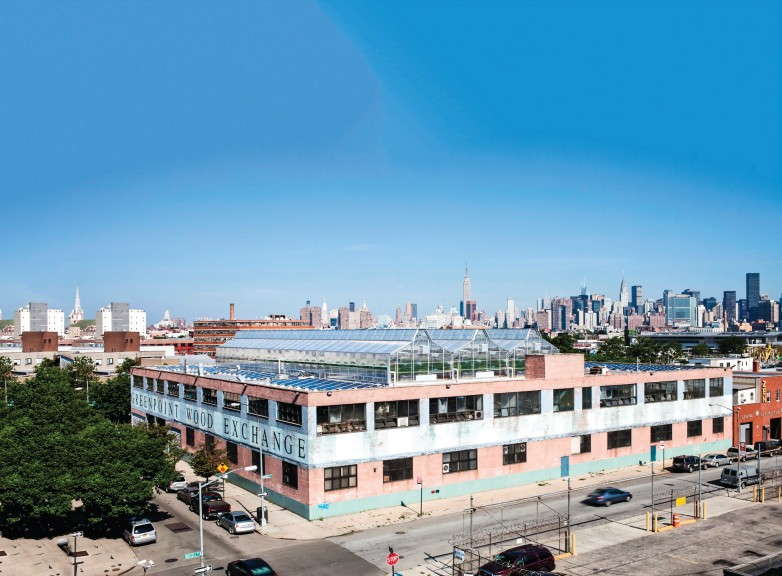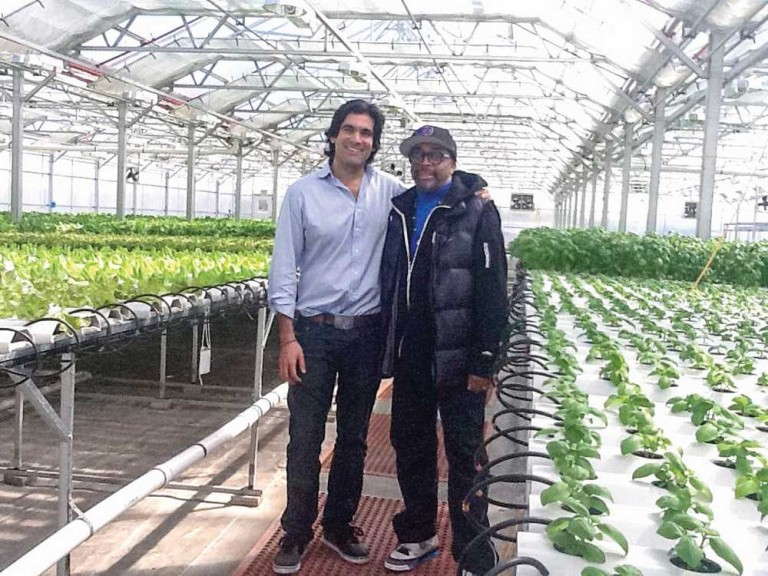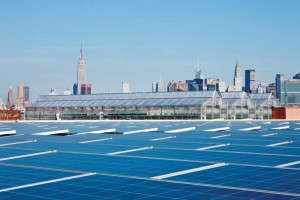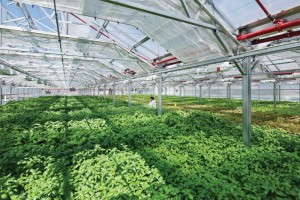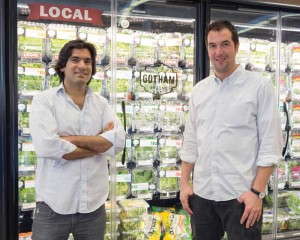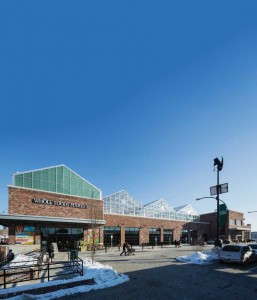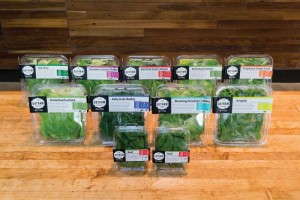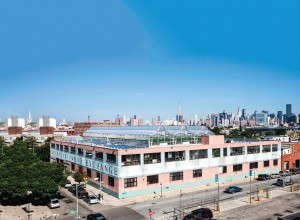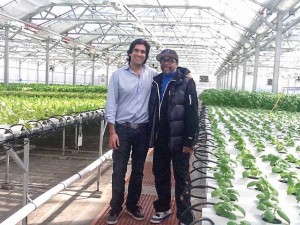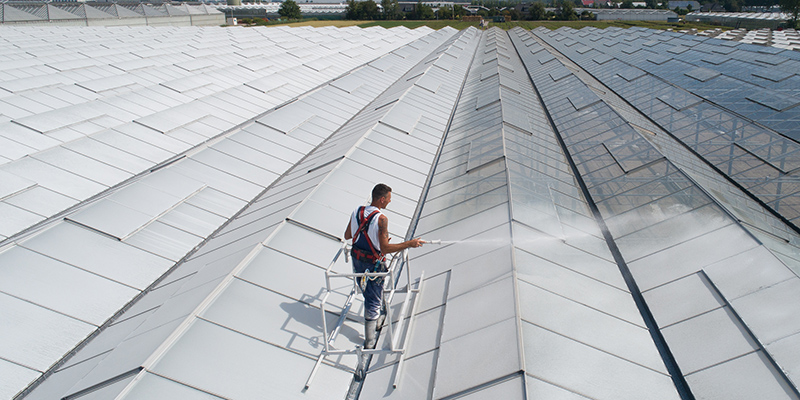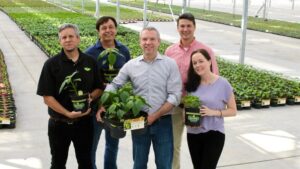Gotham Greens Takes Locally Grown Produce To A Whole New Level
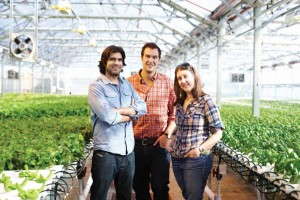
Gotham Greens’ Viraj Puri, Eric Haley and Jennifer Nelkin Frymark
Gotham Greens, based in Brooklyn, N.Y., revolutionized the greenhouse industry when it opened its first farm on the roof of a Greenpoint neighborhood warehouse in 2010. The company tapped into an underused resource by leasing rooftop space to build a 15,000-square-foot greenhouse operation that produces more than 100 tons of leafy greens and vegetables, marketed locally to city grocery stores at competitive prices compared to products that travel many food miles.
Its Greenpoint location was the first commercial-scale rooftop greenhouse in the country, and in the few years since it opened, the founders of Gotham Greens have used what they learned to break new records. In January, Gotham Greens made history again as the first commercial scale greenhouse operation in the world built on the rooftop of a supermarket, and integrated into its sales, when Whole Foods Market opened its Gowanus, Brooklyn neighborhood store. The rooftop greenhouse measures more than 20,000 square feet and will grow more than 200 tons of fresh leafy greens and tomatoes each year, marketed to customers who shop in the store downstairs and at several other Whole Foods locations and local restaurants.
Gotham Greens’ third commercial scale rooftop greenhouse, measuring more than 60,000 square feet, is scheduled to begin crop production in 2014 in the Jamaica neighborhood of Queens. Quickly becoming urban agriculture experts, Gotham Greens is seeking out opportunities for more farms in New York and beyond. CEO and Co-Founder Viraj Puri says Gotham Greens is currently working on two projects in other cities, and hopes to expand its offerings nationally and internationally.
[blackoutgallery id=”60760″]
Growing Gotham Greens From Idea To Reality
The idea first hatched in 2008, when Puri was working in a New York engineering firm with the company’s current Chief Agricultural Officer Jennifer Nelkin Frymark. The two were developing the Science Barge, a greenhouse situated on a former trash barge in the Hudson River. With an interest in locally grown, sustainable food production, Puri was exposed for the first time to greenhouse technology and became enthralled with its possibilities for urban agriculture.
Puri partnered with his friend, Eric Haley, an investment banker and private equity fund manager, and Gotham Greens launched in 2009. Nelkin joined the partners, contributing her considerable knowledge and background in greenhouse systems and production. (See “Meet The Three Young Go-getters Who Created Gotham Greens“.)
At the time, there was a burgeoning food movement, with growing interest among consumers in food production systems and locally grown food. Farmers’ markets were growing in number and popularity and chefs and food writers were becoming household names. Puri calls the launch of Gotham Greens a perfect storm.
“I was exposed to greenhouse technology, looking at all the amazing yields you could get and doing it on a smaller environmental footprint, using less water, eliminating chemical inputs and runoffs, so the idea hatched there,” he says. “We were in the right place at the right time, wanting to do something entrepreneurial in the environmental/sustainability field.”
Initially, the partners knew they wanted to grow produce year-round and that there was a market for it in the city, but open land was obviously lacking in the densely populated city landscape.
“We knew we wanted to grow in greenhouses but when we couldn’t find any sites on the ground, we started to look up, and one vastly underutilized resource we do have in urban areas like New York is unused rooftop space,” Puri says. “So we said, ‘Okay, if we want to do commercial-scale ag and build enough greenhouses so we can grow a meaningful amount of product, maybe we should look at rooftops.’”
The Building Process: How To Put A Greenhouse On A Roof
The process of finding the right building, a landlord who was interested in the idea and making sure the building was structurally sound and would work logistically was an interesting one, Puri says. The building process, too, was unique and many of the contractors and vendors thought the partners were a little bit crazy, to say the least, but they were also intrigued by the idea. Having Nelkin’s knowledge and background proved invaluable in working with the different vendors of greenhouse structures and growing systems, Puri says.
Putting a greenhouse on a rooftop is likely as difficult as it sounds. The construction process includes more work from an architectural and engineering standpoint than a traditionally built structure on the ground, to ensure the building underneath is sound. Space is limited, too, so layout and design is important.
“We have definitely learned a lot through the construction process,” Puri says. “Every building is a little bit different, so some of our projects are retrofits on the existing buildings, some are new construction, so we’ve learned new things from every site, from architecture to engineering to how to layout the greenhouse. It’s just another layer of complexity.”
While Gotham Greens has used some manufacturers in all of its projects, Puri says he is intrigued by new technology and curious to try different things to see what works in given situations, and ultimately on rooftops. Not being able to vary things like tanks has its challenges, but other components have been adaptable, he says. The operation has worked with a variety of greenhouse irrigation, lighting, climate control and hydroponic growing systems vendors. As a hydroponic grower, Gotham Greens uses nutrient film technique (NFT) for its hydroponic crops and highwire production for tomatoes and vine crops.
Premium Plants At Competitive Prices
Gotham Greens produces a wide variety of herbs and leafy greens, including butter lettuce, green leaf, red leaf, arugula, kale, bok choy and basil, as well as seven different types of tomatoes.
Though it is not a certified organic grower, it does use OMRI-certified, organic nutrients in the water. Puri says as a hydroponic grower, it can be tricky to get certified as an organic producer. However, the operation does not use any pesticides or herbicides.
“You can still be certified organic and use pesticides, but for us, the most important thing is to not use pesticides,” he says.
A common question Puri gets about growing on a rooftop is whether there are any air or environmental quality issues affecting the crops due to smog or pollution, but there hasn’t been any evidence of that, Puri says.
“We are largely insulated from any smog-related issues by being in a greenhouse,” he says. “We frequently send our produce out to local labs for testing and haven’t had any sort of adverse effect from being in an urban area. It also helps that we’re a couple of stories up and not at the ground level.”
Pricing for its crops is competitive with comparable products that are shipped in by truck. The difference, Puri says, is that Gotham Greens’ crops are so local, they can be harvested at breakfast and on a consumer’s table by lunch. That freshness resounds with consumers and Gotham Greens has won many accolades — and business — for its products.
“It’s more expensive to produce, being located in the city and having a higher expenditure capital up front for things like utilities and payroll. Labor is typically more expensive in urban areas, especially in New York, which is the most expensive city in the country. But we also cut down on the long distance transportation and logistics that’s required to deliver crops to market, so that enables us to price competitively at the shelf.”
Gotham Greens sells products all over New York City, including grocery stores, supermarkets, restaurants and some online retailers that are popping up — services like Fresh Direct that deliver groceries or baskets of produce to consumers.
Pioneers In Sustainable Urban Production
From the beginning, Whole Foods Market was one of Gotham Greens’ biggest customers. The two companies’ missions and values are closely aligned in that they both place value on high-quality, sustainably produced food. Whole Foods is excited by innovation and supporting local farmers, Puri says, so when Gotham Greens built its first farm, Whole Foods bought much of its product and buyers loved the product.
So when Whole Foods joined the Better Buildings Challenge, an initiative through the U.S. Department of Energy in which it pledged to cut energy consumption by 20 percent by 2020, in its 370 stores that make up 13 million square feet of retail space, it was required to present a showcase project, a facility with innovative, energy-saving measures that can serve as an example. Whole Foods developed its project in the Gowanus neighborhood of Brooklyn, and approached Gotham Greens for help with an idea for the rooftop.
The result was a 20,000-square-foot greenhouse atop the new supermarket building. Whole Foods acts as a landlord for Gotham Greens, but Gotham Greens owns the greenhouse and everything in it. Both the greenhouse and the market are full of energy-saving, sustainable improvements. The market operates 60 percent more efficiently than the average U.S. grocery store, with yearly cost savings of $369,300, according to the New York State Energy Research and Development Authority.
The greenhouse acts similarly to vegetated green roofs, by helping to mitigate the urban heat island effect while insulating the building below. A LEED-accredited professional, Puri is dedicated to sustainability in all of Gotham Greens’ structures and production. Gotham Greens uses onsite renewable energy systems including solar panels, and collects and recirculates water in advanced irrigation systems that use 20 times less water than conventional water while eliminating runoff.
By growing and marketing its crops locally, it eliminates the need for long-distance food transportation and sharply reduces transportation fuel consumption and carbon emissions associated with food miles. And the operation estimates it yields 20 to 30 times more produce per acre than field production while eliminating use of arable land because of its rooftop locations.
Local residents are employed at the operation, and Gotham Greens supports City Harvest, an organization dedicated to providing food to New York’s hungry.
In a city that is the fourth largest energy user in the U.S., with less than 15 percent of its primary energy requirements met from in-state resources, and that imports more than $1 billion in vegetables annually, Gotham Greens is a pioneer in local, sustainable urban food production. But Puri says while the company is optimistic, it humbly recognizes that it’s too early to tell if it’s sustainable long term.
“This is a great concept and a great idea, but I wouldn’t say it’s fleshed out enough that it’s a completely proven solution yet,” he says. “I think urban agriculture has a role to play in the overall food and agriculture system. There are emerging urban farm entities sprouting up all over the country. But there are still not enough examples to point to that have been operational long enough to tell if they’ll be sustainable. So we’re not shouting literally from the rooftop that this is the best and only way to farm. We’re just taking it one greenhouse at a time, but yes, I definitely think it’s sustainable.”
See how Gotham Greens plans to partner with other growers for new ventures in other U.S. cities.
Get to know the three young go-getters who created Gotham Greens.





